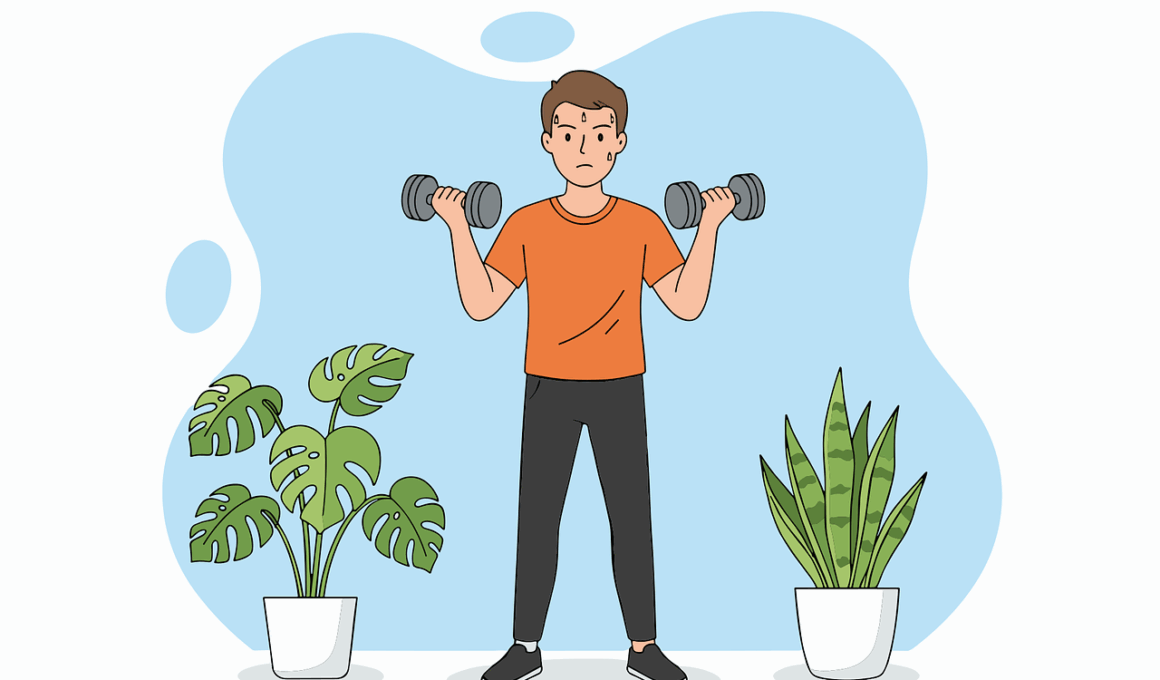Designing a Home Workout Using Agility Ladders
Agility ladders are versatile training tools that can drastically improve coordination, speed, and agility. They are simple to use, making them an excellent choice for home workouts. By incorporating agility ladders into your fitness routine, you can efficiently target various muscle groups and improve your overall athletic performance. Designed with various rungs and materials, they allow for numerous exercises that can fit different fitness levels. Beginners may start with basic footwork drills, while advanced athletes can perform complex movements. Another benefit is their compact size; agility ladders can be easily stored or taken to any location. Preethi, a fitness coach, emphasizes the importance of such tools for anyone wishing to enhance their agility without expensive equipment. Establishing a consistent workout schedule using agility ladders can lead to significant improvements in athletic performance. Incorporating these sessions into a weekly workout plan can also maintain motivation while keeping routines fresh. To maximize benefits, consider pairing agility ladder workouts with strength exercises for a comprehensive fitness regimen. Incorporate dynamic exercises like jumping jacks or high knees before each session to warm up effectively.
Selecting the Right Agility Ladder
When choosing an agility ladder, consider several factors that ensure it meets your training needs and preferences. First, length is crucial; an adaptability to varying drills calls for ladders of sufficient length, ranging from 15 to 30 feet. Check for rungs as well; they should be lightweight yet sturdy enough to withstand intense workouts. While flat rungs are common, elevated options may provide more challenging drills. Portability is another key aspect; opt for foldable models if you plan to work out in various locations, ensuring convenient storage and transport. Durability is equally essential; a long-lasting ladder made from high-quality materials will withstand regular use and potential weather conditions. Now, consider thickness and grip; the ladder should maintain ground contact without slipping during intense movements. Accessories can enhance your experience, including resistance bands or cones that create comprehensive drill setups for strength enhancement. Lastly, budget matters; multiple options cater to different budgets, so research reputable brands within your price range to get the best value for your investment.
Before starting agility ladder workouts, it’s advisable to establish a structured workout routine that ensures progressive training. Begin by allocating specific days for agility work, ideally two to three times weekly, allowing for muscle recovery in between. Each session should include a dynamic warm-up focused on increasing heart rate and flexibility, preparing the body for high-intensity movements. Following the warm-up, allocate time for various agility ladder drills; consider incorporating lateral movements, forward runs, and in-and-out footwork patterns. Focus on technique and speed, emphasizing form over quantity during initial attempts. After performing drills, integrate strength-based exercises to balance your workout, such as lunges or squats. Each session should also conclude with a cool-down phase, including stretching exercises to promote flexibility and prevent injuries. Gradually increasing the complexity and speed of the drills can challenge your fitness over time. Keep a workout journal to track progress, noting any improvements in speed and agility. Modulation in intensity will keep you motivated and engaged, fostering a more effective fitness regimen that maintains excitement and challenges your endurance.
Sample Agility Ladder Drills
There are several engaging drills you can perform with an agility ladder to maximize your training effectiveness and keep workouts exciting. First, the basic high-knees drill requires you to place one foot in each rung while maintaining a brisk pace. This drill enhances leg strength and cardiovascular fitness. Next, the lateral shuffle drill requires you to face sideways as you place both feet in and out of each rung, promoting agility and side movement efficiency. Another excellent option is the in-and-out drill: start with both feet outside the ladder and jump into the first rung, repeating this process across the entire ladder. For an advanced drill, try the crossover run; cross one foot over the other as you move through the ladder, significantly increasing coordination and agility. Lastly, consider the double step drill, where you step twice inside each rung before moving on, demanding control and speed. Always remember to vary your drills for maximum effectiveness, allowing growth in various athletic aspects, which is crucial for overall physical fitness.
Incorporating agility ladder workouts into your weekly regimen can significantly improve performance in various sports. Athletes, particularly those in sports like soccer, basketball, and tennis, benefit immensely from enhanced agility and coordination. Training in quick bursts followed by rest periods can mimic game situations, teaching the body to recover effectively while remaining agile. As you engage in ladder drills, focus on building endurance and explosiveness, targeting fast-twitch muscle fibers critical for athletic success. Moreover, utilizing agility ladders helps improve foot speed and reaction time, essential attributes for competitive athletes. They facilitate lateral movements, crucial for many sports requiring rapid directional changes. Additionally, agility ladder routines foster better cardiovascular health, increasing overall stamina. This workout type is also adaptable; regardless of your athletic discipline, you can modify the drills to suit specific demands. Whether it’s improving sprinting for a sprinter or manual dexterity for a quarterback, the ability to fine-tune workouts caters to personalized athletic needs. Keeping the sessions dynamic and incorporating game-like scenarios can heighten focus and translate effectively to on-field performance.
Safety Tips for Training
Safety should always be a priority during agility ladder workouts, reducing the risk of injuries. Ensure your workout area is clear of obstacles and has an even surface; avoid slippery or uneven ground that could lead to falls. Wearing appropriate footwear is essential to provide adequate grip and support; select shoes designed for performance training or cross-training to enhance stability. Maintain proper hydration and nutrition before workouts, fueling the body for high-intensity activity. It’s also crucial to listen to your body—if you feel pain or discomfort beyond typical muscle soreness, stop the workout immediately. Ensuring you master each drill’s technique is key; incorrect form can lead to unnecessary strain and injuries. Gradually increasing difficulty ensures your body adapts to the workload; avoid overtraining, which may result in fatigue or burnout. Also, allow recovery days between workouts, enabling muscles to repair and grow stronger. Incorporating flexibility and mobility sessions on off days can enhance recovery, promoting long-term health and resiliency. Lastly, consider setting personal goals to remain motivated, tracking progress can help reduce monotony.
As you grow more comfortable with agility ladders and notice improvements, consider advancing your workout intensity or introducing additional equipment. High-intensity interval training (HIIT) can seamlessly complement agility ladder workouts to boost cardiovascular endurance. Pairing these drills with dumbbells or resistance bands can add an element of strength conditioning, further enhancing workout efficacy. For a fun twist, invite friends or family to join your sessions, creating a social and motivating environment that encourages camaraderie and accountability. This can also inspire friendly competition, pushing you all towards improving personal best records. Monitoring your progress through apps or wearable devices can provide valuable insights; tracking metrics such as speed and reaction time can reveal improvement areas. Participating in online challenges or local fitness groups provides added encouragement and variability in your training regimen. Keeping a diverse routine including agility ladders, strength training, and flexibility work fosters well-rounded fitness. Adapting workouts to suit personal goals ensures you enjoy and stay committed to fitness. Consider investing in diversified equipment to further enrich your home gym experience, optimizing your workout potential while keeping things engaging.
In conclusion, designing a workout using agility ladders can significantly improve fitness levels through versatility and engagement. By understanding ladder selection, drill variety, and safety precautions, you can create a successful home workout routine. Regular utilization of agility ladders enhances numerous athletic qualities such as speed, coordination, and endurance. As a dynamic training tool, incorporating these ladders into your fitness regimen promotes overall health and physical performance improvements while keeping workouts enjoyable. Mixing agility sessions with strength training provides a holistic approach to fitness, addressing various muscle groups while promoting conditioning. Establishing a supportive training environment—be it personal or community-focused—can foster motivation and encouragement, keeping individuals engaged in their fitness journey. Always remember that success stems from maintaining consistency and adapting workouts to suit individual needs, ensuring continual improvement. Utilize tools such as fitness journals or apps to track progress and achievement, celebrating milestones along the way. This positive reinforcement contributes to a sustainable fitness lifestyle. Ultimately, utilizing agility ladders can accelerate your journey to better health, improved athletic performance, and heightened enjoyment in physical activity.


